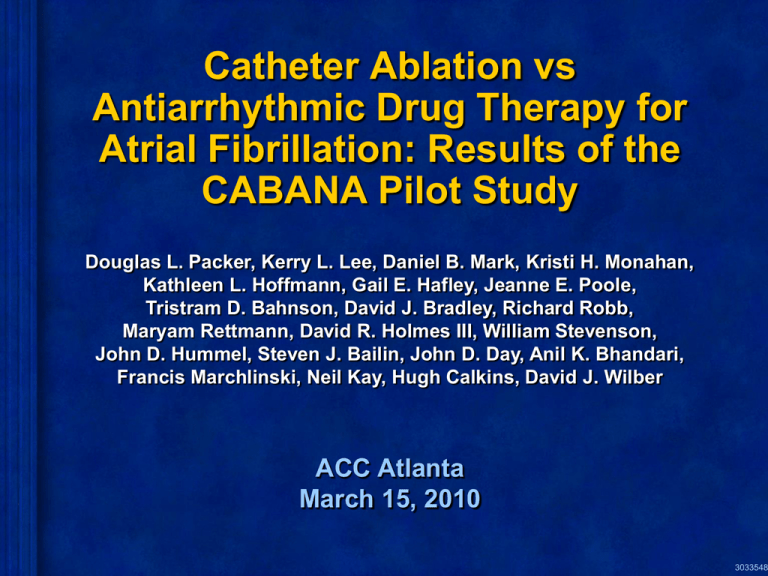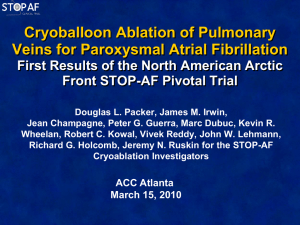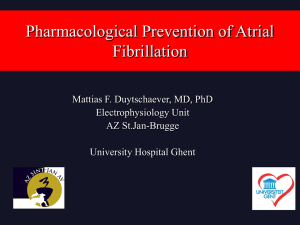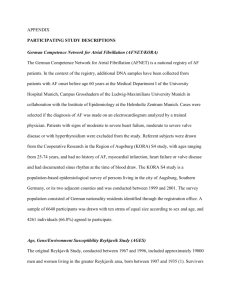CABANA Pilot Study
advertisement

Catheter Ablation vs Antiarrhythmic Drug Therapy for Atrial Fibrillation: Results of the CABANA Pilot Study Douglas L. Packer, Kerry L. Lee, Daniel B. Mark, Kristi H. Monahan, Kathleen L. Hoffmann, Gail E. Hafley, Jeanne E. Poole, Tristram D. Bahnson, David J. Bradley, Richard Robb, Maryam Rettmann, David R. Holmes III, William Stevenson, John D. Hummel, Steven J. Bailin, John D. Day, Anil K. Bhandari, Francis Marchlinski, Neil Kay, Hugh Calkins, David J. Wilber ACC Atlanta March 15, 2010 3033548 Catheter Ablation vs Antiarrhythmic Drug Therapy for Atrial Fibrillation: Results of the CABANA Pilot Study Funded by St. Jude Medical Foundation, St. Paul, Minnesota Research Relationships (DLP) with Biosense, Acuson, Siemens, Cryocath, EPT, St. Jude, Cardiofocus, Symphony, Prorhythm, NIH Royalties from IP licensed by St. Jude Medical Unpaid consulting relationships: Medtronic, Boston Scientific, St. Jude, Biosense, Siemens, Cryocath Other information available from Mayo Communications 3033548 Purpose of CABANA Pilot Study • Determine the freedom from AF with ablation vs drug therapy in patients with more problematic AF and accompanying co-morbidities • Test the feasibility of a long-term pivotal trial for assessing mortality, stroke, hospitalization and cost outcomes CABANA Pilot Study; ACC 2010 3033548 Design of the CABANA Pilot Study Atrial fibrillation Warranting Therapy >65 yr of age or <65 yr with 1 CVA risk factor Eligible for ablation and/ or drug therapy Inclusion Criteria • 2 paroxysmal AF episodes (1 hour) over 4 mos or >1 persistent AF episode (>1 week) • 65 yr of age, or <65 yr with 1 risk factors Hypertension Diabetes R Heart failure Drug Rx and AC • Rate control • Rhythm Rx 1° ablation & AC • PV isolation • Adjunctive Prior CVA or TIA LA size >5.0 cm (Vol In 40 cc/m2) EF 35 % Follow-up 12 months • Eligible for ablation and 2 rhythm control and/or 3 rate control drugs CABANA Pilot Study; ACC 2010 3033548 CABANA Pilot Study Baseline Characteristics in 60 Patients Age (yrs) Age <65 yrs old with 2 risk factors Gender Male / Female (%) 61±10 25 77% 66% 23% Hypertension (%) Diabetes (%) CAD (%) Prior MI (%) Prior CABG/PTCA (%) Dilated cardiomyopathy (%) Congestive heart failure 48 11 21 6 13 10 13 80% 18% 35% 10% 22% 17% 22% Ejection fraction (%) LA size (mm) Left atrial enlargement None (%) Mild–moderate (%) Severe (%) 55 ± 10 4.4±1.0 CHADS2 score 1 2 CABANA Pilot Study; ACC 2010 8 27 15 16% 54% 30% 36 23 61% 39% QuickTime™ and a decompressor are needed to see this picture. 3033548 CABANA Pilot Study QuickTime™ and a decompressor are needed to see this picture. Arrhythmia History Type of AF Paroxysmal Persistent Long standing persistent Years since first AF episode (yrs) CCS AF severity Class 1-2 Class 3-4 Prior anti-arrhythmic drugs (no.) 0 1 2 Hospitalized for AF Direct current cardio-version History of atrial flutter CABANA Pilot Study; ACC 2010 19 22 19 32% 37% 32% 3.3±4.6 18 35 32% 61% 42 15 3 28 32 14 70% 25% 5% 47% 53% 23% 3033548 CABANA Pilot Study QuickTime™ and a decompressor are needed to see this picture. Treatment Drug Therapy Ablation n=31 29 (100) 100 100 22 71% 80 n=25 89% 80 60 60 % n=13 46% % 40 20 n=29 40 4 13% 5 16% n=11 38% n=6 21% 20 n=1 4% 0 0 Rate Rhythm Rate & rhythm PV WACA/ Linear isolation antral Abl isolation CFAE GP CABANA Pilot Study; ACC 2010 3033548 QuickTime™ and a decompressor are needed to see this picture. CABANA Pilot Study First Post-Blanking AF Event Over Follow-up 1st AF episode (%) 100 Drug (n=31) Ablation (n=29) 80 60 n=16 52% 40 n=7 24% n=3 10% 20 n=3 10% n=1 3% n=4 14% 0 3-6 6-9 9-12 Months CABANA Pilot Study; ACC 2010 3033548 Freedom from Recurrence of Symptomatic Atrial Fibrillation Post Blanking Period 100 Freedom from AF recurrence HR 0.42 (0.19-0.95) P=0.033 80 Ablation 60 65% Blanking period* 40 41% Drug Rx 24% 20 0 0 3 6 9 12 Time (months) 1 28 2 31 27 30 23 16 20 13 7 7 3033548-1 Freedom from Recurrence of Any Symptomatic AF, AFL, or AT Freedom from AF/AFL/ AT recurrence 100 HR 0.46 (0.21-0.99) P=0.042 80 Ablation 60 61% Blanking period* 23% 38% 40 Drug Rx 20 0 0 1 2 28 31 3 6 9 12 27 30 22 16 19 12 7 6 Months since treatment start 3033548-1 CABANA Pilot Study Cross-Overs and Redo Therapy 30 Drug Rx n=31 QuickTime™ and a decompressor are needed to see this picture. Ablation Rx n=29 n=8 28% n=6 21% 20 n=4 13%* Pt (%) 10 0 CABANA Pilot Study; ACC 2010 Crossover to Abl AA Rx Re-ablation *2 failed Ic; 2 failed IIIs 3033548-1 Maintenance of Sinus Rhythm in CABANA Pilot at 12 Months 100 AAD Rx n=18 QuickTime™ and a decompressor are needed to see this picture. Ablation Rx n=29 80 60 n=15 n=13 40 n=17 n=17 +2 pt +0 pt No AF on drug Non AF with redo +2 pt n=5 20 0 No AF on Rx No AF No drug No AF Late off drug CABANA Pilot Study; ACC 2010 3033548-1 CABANA Pilot Study Recurrence of Any AF, AFL, or AT AF/AFL/AT recurrence (%) 1.0 QuickTime™ and a decompressor are needed to see this picture. HR 0.69 (0.37-1.32) P=0.264 (72) 0.8 Drug (59) 0.6 Blanking period 66% (50) 0.4 72% Ablation (36) 0.2 0.0 0 3 6 9 12 14 8 4 5 Time (months) Ablation Rx Drug Rx 29 31 CABANA Pilot Study; ACC 2010 26 30 18 12 3033548-1 CABANA Pilot Study QuickTime™ and a decompressor are needed to see this picture. Perception of Atrial Fibrillation 100 Drug (n=31) Ablation (n=29) Patients (%) 80 60 61 64 40 29 20 8 13 4 0 Baseline 3 mo 12 mo CABANA Pilot Study; ACC 2010 3033548-1 Adverse Events in the CABANA Pilot Study DVT (%) AV fistula/pseudo aneurysm (%) CVA/TIA (%) PV stenosis Moderate (50-75%) Severe (75-95%) Atrial esophageal fistula (%) Tamponade (%) Congestive heart failure (%) Volume overload (%) Myocardial infarction (%) Bradycardia (%) Ventricular tachycardia (%) Atrial flutter (%) LFT increase (%) UTI (%) Death, Cardiac Arrest, CVA CABANA Pilot Study; ACC 2010 Ablation n=29 1 (3.4) 2 (6.8) 1 (3.4) 1 (3.4) 0 (0) 0 (0) 1 (3.4) 3 (10.2) 2 (6.8) 1 (3.4) 1 (3.4) 0 (0) 0 (0) 0 (0) 1 (3.4) 0 (0) Drug Rx n=31 1 (3.2) 0 (0) 0 (0) 0 (0) 1 (3.2) 1 (3.2) 1 (3.2) 0 (0) 0 (0) 3033548-1 Limitations • Limited number of subjects in this pilot study • Follow-up was limited to 12 months • As expected a small number of patients crossed over from drug to ablative therapy • Small numbers of at risk patients at 12 months limiting “late” conclusion that can be drawn CABANA Pilot Study; ACC 2010 3033548-1 Conclusion of the CABANA Pilot Study • Ablative intervention was more effective than drug therapy for preventing recurrent symptomatic atrial fibrillation • Treatment success rates in this population, which include a significant percentage with persistent and long-standing persistent AF, were lower than observed in other randomized clinical trials • Late recurrence of AF may reduce long-term effectiveness of ablation • This pilot study establishes the feasibility and importance of conducting a pivotal trial for establishing long-term outcome, mortality, quality of life, and cost of therapy for AF CABANA Pilot Study; ACC 2010 3033548-1 CABANA Pilot Sites • Mayo Clinic • Loyola University • Mercy Med/Des Moines • Ohio State • Intermountain Med Center • Good Samaritan • University of Alabama • Mass General Boston • Johns Hopkins • Brigham and Womens • University of Pennsylvania QuickTime™ and a decompressor are needed to see this picture. Doug Packer Dave Wilber Steve Bailin John Hummel Crandall/Day Anil Bhandari Neal Kay Reddy/Ruskin Hugh Calkins Bill Stevenson Callans/Marchlinski Enrolled: 60 of 60 patients CABANA Pilot Study; ACC 2010 3033548-2


